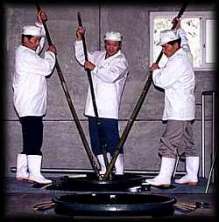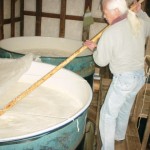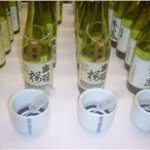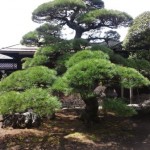Giving credit where credit is due!
Recently, I read an article that came to me mysteriously by email about how winemakers  in general deserve more attention and credit. The article suggested that too often folks fall in love with terroir, i.e. all that connects a wine to a certain place, and as such that the role of the person who actually called all the technical shots along the way gets downplayed, and that that shouldn’t be. The gist of the article was that hundreds of decisions are made between grape and bottle, and that deserves to be recognized and appreciated as well.
in general deserve more attention and credit. The article suggested that too often folks fall in love with terroir, i.e. all that connects a wine to a certain place, and as such that the role of the person who actually called all the technical shots along the way gets downplayed, and that that shouldn’t be. The gist of the article was that hundreds of decisions are made between grape and bottle, and that deserves to be recognized and appreciated as well.
Which got me thinking: what about toji? Does the master brewer at a sake brewery get the credit that he or she deserves in creating a great sake?
Very often, perhaps as often as in the wine world, the person that guided and influenced  the process gets very little attention or credit. It goes to the rice, or the generations of great sake that forged the reputation of the brewery, or sometimes even the region in general f’gad’s sake. Rarely, or at least not often enough, does it go to the toji.
the process gets very little attention or credit. It goes to the rice, or the generations of great sake that forged the reputation of the brewery, or sometimes even the region in general f’gad’s sake. Rarely, or at least not often enough, does it go to the toji.
So: Does the toji matter? Hell yes, the toji matters!
Long ago, the toji mattered, arguably, even much more than today. Back in the day, kuramoto (the brewery owners themselves) rarely even entered the brewery. And when they did, it made the brewing staff antsy, it did. “What’s he doing in the kura? He doesn’t have any business in here!” But things have changed.
Remember, back in the day, most toji brewed fairly close to home, and had but one style to aim for (the local one), and was pretty much stuck with local rice. But all that has changed. These days, toji might travel very far from home. The rice they use might be from anywhere, and brewers have a much bigger market at which to aim than the local yokels. Often, the kuramoto (the brewery owners themselves) dictate what is to be brewed, and the toji just complies. Either way, the toji is making gazillions of decisions about each fermenting tank every day.
aim for (the local one), and was pretty much stuck with local rice. But all that has changed. These days, toji might travel very far from home. The rice they use might be from anywhere, and brewers have a much bigger market at which to aim than the local yokels. Often, the kuramoto (the brewery owners themselves) dictate what is to be brewed, and the toji just complies. Either way, the toji is making gazillions of decisions about each fermenting tank every day.
In fact, in these modern times, there are more or less two ways of coexisting: one in which the kuramoto leaves it up to the toji and stays out of his way, and the other in which the toji brews up whatever is ordered by the kuramoto. Both are alive and well and living in Japan.
And let us also remember too that more and more often those two are the same: the
kuramoto is the toji, owner-toji as they are called. As tough as this can be, it eliminates a lot of problems. (Assuming schizophrenia is not part of the equation, of course. But I digress.)
The interesting if unrequested article that came to me also touched on the concept of manipulating wines, and my own reading on that subject indicated that the jury is still out on how much or how little of this is acceptable. But it again got me thinking.
 While surely the same argument can be had for sake, at least to some degree, even the most un-manipulated sake has the bejeezus manipulated out of it from start to finish. The rice is milled, soaked, steamed, molded, mixed and forced to temperature. Water is added as needed, alcohol might be added, and the mixture is pressed at the end. Each of these manhandling steps has myriad aspects that combine to become part of the aforementioned gazillion decisions.
While surely the same argument can be had for sake, at least to some degree, even the most un-manipulated sake has the bejeezus manipulated out of it from start to finish. The rice is milled, soaked, steamed, molded, mixed and forced to temperature. Water is added as needed, alcohol might be added, and the mixture is pressed at the end. Each of these manhandling steps has myriad aspects that combine to become part of the aforementioned gazillion decisions.
Having said that, any toji will tell you that he or she doesn’t really make sake per se, they just prepare the ingredients, create as an ideal an environment as possible for what they want to accomplish, and get out of the way. The sake brews itself, with a mind of its own.
Does a toji manipulate a sake? Hell, yes! Does it matter? Hard to say!
One owner of a somewhat large brewery once shared with me his thoughts on a what makes a great toji. After several glasses of some of his own fine hooch, he got down to the truth.
 “You know what makes a great toji? I’ll tell ya what makes a great toji! Forget this gold medal stuff. Forget the prizes. Gold, schmold! Give me a person who year-in and year-out can deliver consistent quality of sake, the same stuff no matter what happens. No matter what the rice is like, no matter how warm the winter is, no matter what major piece of equipment breaks down in the peak of the season, no matter what personality conflicts he has in his team, and no matter who gets sick when… he still manages to brew consistent, dependable sake! Now that is a great toji”
“You know what makes a great toji? I’ll tell ya what makes a great toji! Forget this gold medal stuff. Forget the prizes. Gold, schmold! Give me a person who year-in and year-out can deliver consistent quality of sake, the same stuff no matter what happens. No matter what the rice is like, no matter how warm the winter is, no matter what major piece of equipment breaks down in the peak of the season, no matter what personality conflicts he has in his team, and no matter who gets sick when… he still manages to brew consistent, dependable sake! Now that is a great toji”
So yes, in the final analysis, toji make a huge difference and should be lauded much more than they are.
Do some get attention? Yes, mei-toji (famous toji) have always been a part of the industry, and there are a handful that are recognized as such. A few have even been designated by their local prefectural or the national government as famous craftsmen or even intangible cultural assets. But still, not as many as one might think, and certainly not as many as are deserving of such recognition.
Why does this not happen more often? One reason is that they are a humble lot. Traditionally, toji were happy to stay in the background, being masters of their realm was enough, and even those with tyrannical streaks could be tyrants in that slice of their universe. Traditionally, they were not meant to be the “face” of the sake; that was the kuramoto’s job. To the outside world they were just doing their job.
But this is all changing, and so I say yes, let us make a bigger deal of the toji, and a more personal deal out of them too. They deserve it.
There are still a couple of seats remaining open for the Sake Professional Course in Japan, the most thorough sake education on the planet. Five days of sake bliss: learning, tasting, eating and visiting breweries. Held in Tokyo with a trip to the Kyoto-Osaka-Kobe area. Learn more at http://www.sake-world.com/html/spcjapan.html





